
Incheon, formerly Jemulpo or Chemulp'o (Korean: 제물포) until the period after 1910, officially the Incheon Metropolitan City (인천광역시), is a city located in northwestern South Korea, bordering Seoul and Gyeonggi Province to the east. Inhabited since the Neolithic, Incheon was home to just 4,700 people when it became an international port in 1883. As of February 2020, about 3 million people live in the city, making it South Korea's third-most-populous city after Seoul and Busan.

The Gyeongin Line (Gyeonginseon) is a railway mainline in South Korea, currently connecting Guro station in Seoul and Incheon. Commuter services along the line through operates into Seoul Subway Line 1.
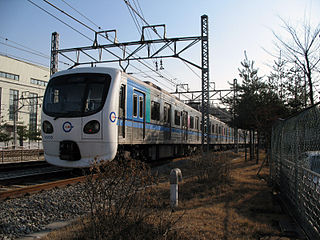
The Incheon Subway is a subway system serving the South Korean city of Incheon. The system is operated by Incheon Transit Corporation, and is part of the greater Seoul Metropolitan Subway.

Yeongdeungpo District is an administrative district in southwest Seoul, South Korea. Although the origin of the name is uncertain, the first two syllables are thought to be from "yeongdeung" (靈登) or "divine ascent", a shamanic rite. The third syllable is "po", representing the bank of a river (浦), referring to the district's position on the Han River. The 2006 population was 408,819.

Jamsil Station (Korean: 잠실역) is an underground station on Line 2 and Line 8 of the Seoul Metropolitan Subway. Lotte World is continuous with the Line 2 station. The station is also called Songpa-gu Office Station (Korean: 송파구청역), due to the proximity of the office building.

Express Bus Terminal Station is a station on Seoul Subway Line 3, Line 7, and Line 9. The stations are located in the Greater Gangnam Area, Banpo-dong, Seocho District, Seoul, Korea.
Seoul, the capital and largest city in South Korea, accounts for only 0.6% of the country's total land area, yet it is home to around 19% of the population. The population density in Seoul demands a great deal of the city's transportation systems, which are regarded by many as among the best and most advanced in the world. Seoul is very well connected by its subway and bus systems, and the city is also very supportive of pedestrian foot travel. In 2006 it won the Sustainable Transport Award.

Yeongdeungpo station is a ground-level railway station in Seoul, South Korea. The station is located in Yeongdeungpo Dong, Yeongdeungpo-gu, and is a stop on the Gyeongbu Line, Honam Line and Seoul Subway Line 1. The station is integrated into the Yeongdeungpo Lotte Department Store. Located in the station are Lotteria, Dunkin' Donuts, Krispy Kreme, and KFC.

Guro Station (Korean: 구로역) is a subway station in Guro District, Seoul, South Korea. It serves Seoul Subway Line 1.
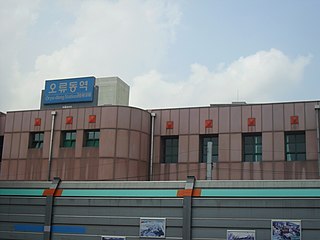
Oryu-dong station is a metro station on Line 1 of the Seoul Subway. It was opened when the Seoul–Incheon line was first introduced during the Japanese occupation era.
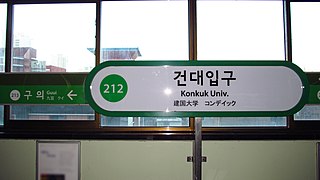
Konkuk University Station is a rapid transit station on Seoul Subway Line 2 and Seoul Subway Line 7. It is located in Hwayang-dong in the Gwangjin-gu administrative district of Seoul. It is adjacent to Konkuk University from which it takes its name. Line 2 is serviced by an elevated platform while Line 7 is serviced by an underground platform. The station has connections to ten bus lines through its six exits as well as a connection to the airport shuttle bus. The station services Hwayang-dong as well as Jayang-dong and Noyu-dong. The area around the station is mixed residential and small commercial businesses. Exits from the underground Line 7 platform open into Konkuk University and the adjacent Star City shopping and high-rise residential tower complex.
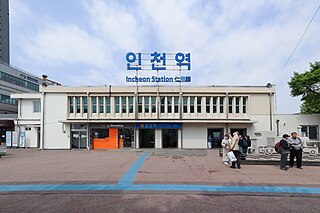
Incheon Station is the western terminus railway station of the Suin–Bundang and Gyeongin lines of the Seoul Metropolitan Subway. The station is in the Bukseong neighborhood of the Jung District, Incheon, South Korea and is approximately 20 kilometers west of Seoul. Established in 1899 under the Korean Empire as Chemulpo Station, Incheon Station is the oldest train station in the Seoul Capital Area. During the Japanese occupation of Korea, the station was briefly named Hainchon Station and the original station building was destroyed during the Korean War. Service for the old Suin Line began in 1937 and ended in 1995; the new Suin Line was extended to the station in 2016. Service for the Gyeongin Line began in 1974.

Jihaeng Station is a ground-level metro station on Line 1 of the Seoul Subway in Jihaeng-dong, Dongducheon, South Korea. It opened on January 30, 2005, to services on the Gyeongwon Line and services on the Seoul Metropolitan Subway began calling here on December 15, 2006. The station offers access to Dongducheon Foreign Language High School, Central Middle and High School, Jihaeng Elementary School, Science Tower and Songnae-dong Office, among other places.
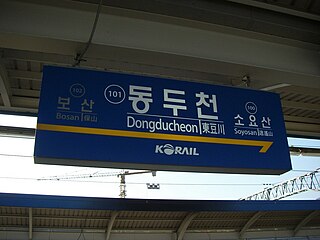
Dongducheon Station is a metro station located in Dongducheon, South Korea. Seoul Subway Line 1 serves this station, and it is the terminus station for Gyeongwon Line express trains. Camp Casey, a U.S. Army military base, is located nearby.
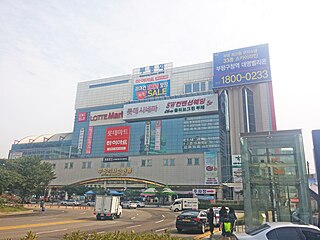
Bupyeong station is a subway station located in Bupyeong District, Incheon, South Korea. This station is on the Seoul Subway Line 1 and Incheon Subway Line 1. It is one of the busiest stations on the Incheon line because of its central location and its connection to the Seoul line.

Incheon Bus Terminal, not far from Incheon City Hall, is the busiest bus station in Incheon, South Korea and the main gateway for intranational buses connecting Incheon city. It is operated by Incheon Transit Corporation which was founded by the city government.

Incheon Subway Line 2 is a driverless, medium-capacity subway line running 29.2 km (18.1 mi) from Oryu-dong in Seo-gu to Incheon Grand Park, with 27 stations, part of the Incheon Subway system. The line is also included as a part of the overall Seoul Metropolitan Subway network; Juan station has a free transfer with Seoul Subway Line 1, Geomam station connects with the AREX Line to Incheon International Airport and Seoul Station, and Seongnam also has a free transfer with Seoul Subway Line 7.
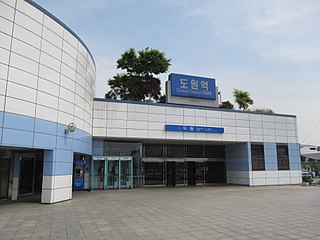
Dowon Station is a station on Seoul Subway Line 1. It is on Gyeongin Line. It was opened in 1899 as Ugakdong Station, which was terminated from service in 1906. The station was reopened in 1994.
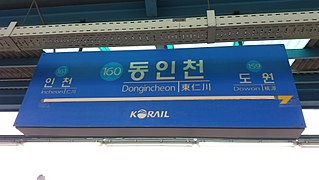
Dongincheon Station is a railway station on Seoul Metropolitan Subway Line 1 and Gyeongin Line located in Inhyeon-dong, Jung District, Incheon. Upon its opening in 1899, the station was known as "Chukhyeon Station", and in 1955, received its current name. The subway service started in 1974.
Hagik Station is an under-construction railway station on Suin-Bundang Line of the Seoul Metropolitan Subway system.



















